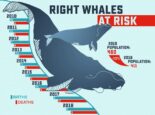Saving the North Atlantic right whale
On the brink of extinction
Once plentiful, the North Atlantic right whale was hunted nearly to extinction by early 20th century whaling. After rebounding slightly in the 1990s, the population has once again been driven to the brink by entanglements in fishing gear and collisions with vessels. Only about 350 North Atlantic right whales remain, making them one of the most endangered large whale species on Earth. The Southeast U.S. is the only place on the planet the whales are known to give birth and raise their young.
These magnificent whales are barely hanging on — in fact, fewer than 70 reproductive females are left, making the need to stop needless human-caused deaths even more urgent. Thanks to scientists and experts working hard to save this species, we know there are solutions. If we don’t come together to take meaningful action now, we could lose these whales forever.
Sierra Weaver, Senior Attorney and leader of SELC’s Coast & Wetlands Program
Supporting species recovery
SELC is working with partners to address the leading and emerging threats to the species and their migratory route and calving grounds. We have weighed in on the need to implement critical policy solutions to protect them from entanglements in commercial fishing gear. We are also attempting to eliminate the risk of whales being seriously injured or killed by vessels in Southeast waters through common-sense measures like slowing down certain vessels in certain times and areas. While these efforts have been effective where they already apply, they need to be expanded to cover larger areas and more vessel classes. We have supported proposed changes to current laws that do just that. Finally, we are working hard to ensure that future offshore wind development on the Mid- and South Atlantic Coasts proceeds with essential protections for these vulnerable whales.
Protecting whales in court
North Atlantic right whales already face extraordinary manmade threats in the ocean, and offshore drilling would have introduced another. To locate potential oil deposits, seismic-blasting boats bombard the ocean with sound waves so loud they can disrupt the whales’ ability to communicate and feed. We went to court to prevent seismic companies from launching their boats. The seismic companies later said they would not seek permits to map the Atlantic seabed.
Additional Resources


